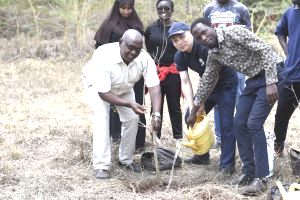Prof Robert Wahiti Gituru, the African Director of the Sino-Africa Joint Research Centre (SAJOREC) based at JKUAT has collaborated with other researchers on a paper that was recently published in the Nature Journal.
The study offers insight on the evolutionary route of baobab trees, identifying Madagascar as the cradle of all the baobab species.
The study, titled ‘The Rise of Baobab Trees in Madagascar’, was spearheaded by the Wuhan Botanic Garden (WBG) and the Sino-Africa Joint Research Centre (SAJOREC), and published in the Journal Nature last month.
The study is in itself a very significant step towards better understanding of these well-known trees, which are revered for their cultural and ecological importance.
The researchers investigated eight baobab species, six of which are present in Madagascar, one across Africa, and one in north-west Australia. They examined the genomes of each baobab species to discover the tree’s ancient origins, tracking it back to Madagascar 21 million years ago.
Their findings, which drew on high-quality genetic data from all eight existing baobab species, indicated that Madagascar was most likely the site of baobab diversification, from which the species later spread to Australia and the African continent.
The team reports, diverse baobab species emerged across Madagascar, driven by ecological competition and environmental conditions including altitude, sea level and volcanic activity.
According to the study, the Baobab tree, often referred to as “mothers of the forest” and “trees of life” in Madagascar, faces a significant threat to its survival and population dynamics, with rising sea levels caused by climate change potentially impeding baobabs’ natural range expansion.
READ ALSO:
Higher Education stakeholders in Malawi visit JKUAT for benchmarking
With the tree under threat, researchers equipped with key data have embarked on a critical quest with the hope of revealing critical indications for the preservation of these trees in the face of continually changing environments.
“Specifically, the study findings justified a recommendation for a greater conservation status for two endangered Malagasy species, including the famous gigantic baobab Adansonia grandidieri, due to the substantial risks to their existence,” observed Prof Gituru.
In order to promote conservation efforts and ensure wider understanding of the distinctive qualities of baobab trees, the researchers intend to increase the scope of their sampling efforts in the future.
Prof Gituru is an Associate Professor of Plant Biosystematics in the Department of Botany at Jomo Kenyatta University of Agriculture and Technology, where he has conducted substantial studies and conservation on the Baobab tree.
One of his most notable conservation initiatives was the planting of over 200 baobab saplings in partnership with the JKUAT Association of Green Energy (JAGE) JKUAT in SAJOREC’s Botanical Garden, to improve plant cover and conserve the species ex situ.
You can also follow our social media pages on Twitter: Education News KE and Facebook: Education News Newspaper for timely updates.
>>> Click here to stay up-to-date with trending regional stories






